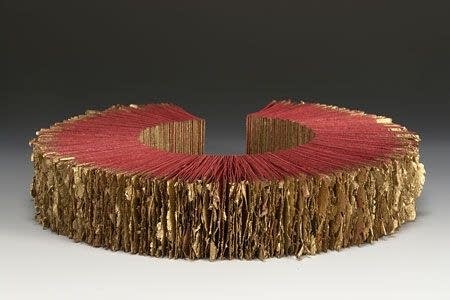The book as art form

[image]
Erica Spitzer Rasmussen's "Book of Sustenance"
When is a book not a book? And when is something that doesn't appear to look at all like a book, actually a work of "book art?"
These are the questions I keep returning to when I see a show at the Minnesota Center for Book Arts, because - like all good art - the works on display regularly challenge my assumptions about what is, and what could be.
Create a More Connected Minnesota
MPR News is your trusted resource for the news you need. With your support, MPR News brings accessible, courageous journalism and authentic conversation to everyone - free of paywalls and barriers. Your gift makes a difference.
Currently on display in the Center's gallery space is a group show called "Parts of a Whole"; it consists of work by MCBA staff, faculty, co-op members and past artists-in-residence.
MCBA Managing Director Jeff Rathermel says while on the surface many of the works look nothing like books, they share themes of repetition, storytelling, and time.
It's the true power of a book that you have a time element within it, rather than just one snapshot view. Unlike a photograph or a painting, you have more time with the viewer/reader... you repeat ideas to emphasize them, you build upon them. But that's also a real responsibility and a challenge. To do this successfully you need to be a "page-turner" to engage people in the entire process - an artist book has a lot more in common with a film or a musical score than it does with traditional print-making.
[image]
Julie Sirek's "A Family Matter"
After perusing the exhibition, I was interested by strong themes that emerged around domesticity and women's work.
One of the most powerful works in the exhibition is Julie Sirek's "A Family Matter." It consists of 30 miniature dresses, made from gampi paper, thread, glass and wire. Sirek made each of these dresses to represent the 30 women from Minnesota who died as a result of domestic violence in 2009. Rathermel says in this work, each dress is in essence a page in a haunting narrative.
The delicateness of those small dresses really works well as a metaphor of vulnerability. And the other thing that I think is really interesting, is that it demands intimacy. Each of those dresses appears relatively similar, but as you start to engage with it you see that each one is unique. By demanding that intimacy you're pulled into a very uncomfortable situation - it's a quiet and powerful conversation.
From a distance, the dresses appear innocent and pretty. But once you move up close you notice subtle differences; one has a tear in the skirt, another a cigarette burn in the chest, a third has wire thorns in the collar. Each of them has been disfigured in some way.
[image]
Chandler O'Leary's "Mnemonic Sampler"
On the opposite wall is a piece with a completely different, far more playful, tone. Chandler O'Leary's "Mnemonic Sampler" consists of embroidered letters of the alphabet, alongside images of ordinary objects whose names start with the given letter (N is for needle, O is for oven mitt, etc). Rathermel says Leary is known for exploring what we have traditionally called "women's work."
At one level it's playful and whimsical, with great detail and humor, but I think there's also this addressing of the "art vs craft" hierarchy, and addressing what we've typically thought of as "women's work" in the community. Certainly it's much better now, but we still have these biases... I think Chandler is interested in reclaiming some of these craft traditions, to say that it's more than just women's work, and that anything done at this particular level could be considered art.
[image]
Detail of Erica Spitzer Rasmussen's "Book of Sustenance"
Erika Spitzer Rasmussen seeks to raise the life of the working-mother to that of high glamour. Her "Book of Sustenance" is a wearable work - similar to a ruffled collar that Queen Elizabeth might have worn. But this collar consists of a grocery list printed on grocery bags stained in cherry Kool-Aid. The result, Jeff Rathermel says, is both stunning... and unsettling.
She's worked with corsets in the past - this notion of being both decorative and restrictive;To have something this big around your neck...and in this case, blood red. She's talking about sustenance and food, and yet collar appears to restrict your throat.
In her artist statement, Rasmussen referred to the repeated pages on the collar as a sort of "mantra for domestic divadom."
"Parts of a Whole" runs through April 24 at the Minnesota Center for Book Arts.